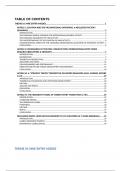Samenvatting
Theme III: MNE Entry Modes (Literature Summary)
This is a complete summary of all literature regarding Week I: Core IB Theories for the course 'Theories of International Business'. The summary is designed to give an easy-to-read insight into the core aspects of each paper. Papers covered include: ARTICLE I: LOCATION AND THE MULTINATIONAL ...
[Meer zien]




